
Original Link: https://www.anandtech.com/show/978
Memory Module Technologies: TCP, EPOC and FEMMA
by Andy Hui on August 26, 2002 8:58 AM EST- Posted in
- Memory
Much of the focus upon RAM these days is the ever-increasing speed of the various rival technologies: with DDR-II just around the corner and RDRAM continuously scaling further in clock speed, it's no wonder that performance and bandwidth are the main talking points.
The typical DIMM, and indeed a RIMM, have not changed much over the past few years. Perhaps the most visible evolution is the heatspreader, which is present on all RIMMs, and some high-performance DDR SDRAM DIMMs, designed to assist cooling.
It would not be difficult to come up with the conclusion that DRAM module development is not going anywhere very fast. This however, is not the case, especially in the server market.
Servers are well known for their sometimes unconventional RAM requirements. OEMs try to offer as much RAM as they can, working with two constraints: limited DIMM slots and limited RAM device densities. Netlist an ASEM (Application Specific Embedded Modules) designer came up with the double height DIMM, which satisfies these two limitations.
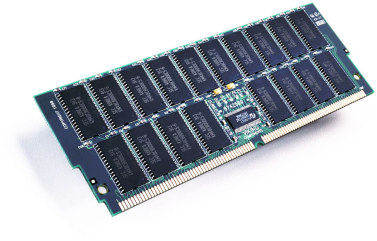
The monster double high DIMM
While the double height DIMM does get the job done by almost doubling the PCB area and therefore the number of DRAM devices, there is a third constraint that is relevant to servers.
Rack space is always at a premium. With the push towards maximum space efficiency and 1U servers, it is necessary to pack as much as possible within a limited space, and massive double height DIMMs are obviously NOT going to fit in a 1U, 2U or maybe even a 3U case, even when the slots are angled.
A number of RAM manufacturers are taking an active role in resolving this issue, resulting in recent developments that advance memory module technology. Using a little bit of clever thinking, Elpida and Kingston have come up with a way to avoid the huge DIMMs by going 3D: mount two memory devices over each other on a standard height DIMM.
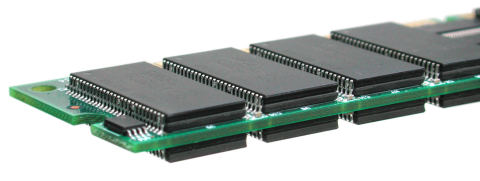
While the idea of stacking two TSOPs (Thin Small Outline Packages) has been
floating around for a few years, Elpida and Kingston have only recently come
up with new methods improving on
this design.
Kentrontech, another RAM manufacturer, decided to take a slightly different
approach, and use two PCBs side by side.
Elpida is a name that you may
not be familiar with, but the two companies behind
the Elpida joint venture, Hitachi and NEC, have been long time players in the
memory industry.
Elpida uses the Tape Carrier Packaging (TCP) technology, which is used to stack
and mount 36 pieces of DDR SDRAM on a single DIMM. This proprietary packaging
technology offers improved thermal characteristics over conventional TSOP
stacked modules, and enables a thinner module package (4.8 mm vs. 6.8mm). The
DDR devices used on the modules are produced with Elpida's 0.13 micron process
technology, supporting 2.5 Volt operation and Error Checking and
Correction (ECC).
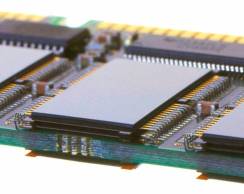

The result is a slimmer, low profile, thermal-efficient, high-density DIMM that
is designed with a 1.2-inch height
to allow the maximum number of DIMM modules in in a space-limited 1U rack
server.

Elpida's 1.2 inch 2 Gigabyte DDR SDRAM DIMM using stacked TCPs
Kingston, a manufacturer that just about anyone who buys ram should be familiar with, developed the EPOC (Elevated Package Over CSP) Techonology.
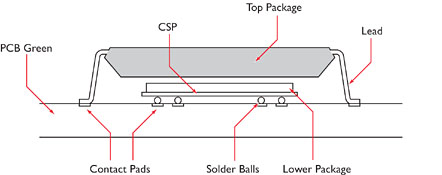
The EPOC technology mounts DRAM chips in different packages in two overlapping
rows on the printed circuit board. The top tier is a row of raised Thin-Small
Outline Package (TSOP) memory chips, and the lower tier is a row of smaller Chip
Scale Package (CSP) memory chips. There are no chip-level interconnects or
physical contact between the two overlapping rows. With the EPOC technology, the
two rows of memory chips are not in direct contact, thereby allowing airflow
in-between the top and bottom chip rows for more effective heat dissipation.
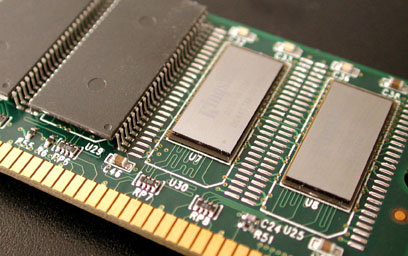
A view of the EPOC DIMM showing the CSP and the TSOP
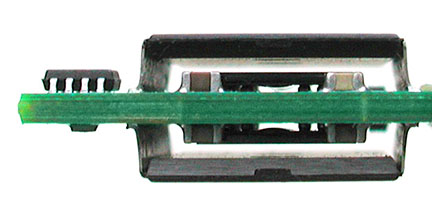
Side view of the EPOC DIMM
Kingston designed EPOC to address three issues. They set out to eliminate the
long lead-times required to stack
memory chips when using third-party stacking companies. Such lead-times impact
customer order shipments and can have significant financial impact when memory
prices fluctuate. Kingston engineers also set a design objective
requiring the new technology to be as easy to manufacture as standard modules.
The final goal was to enhance
thermal performance and overall reliability.
Kingston further says that the EPOC memory modules are an alternative to
stacked-chip modules that will enable
Kingston to stabilize the memory pricing volatility involved with third-party
chip-stacking and reduce the
production delays from weeks to days.
Kentron Technologies, another pioneer
in memory solutions and best known for
their Quad Band Memory, have also tried their hand in creating something that
resolves the size issue.
The result is quite different to what Kingston and Elpida came up with. The
Foldable Electronic Memory Module
Assembly (FEMMA) technology involves two separate PCBs, connected via a flexible
circuit tape component.
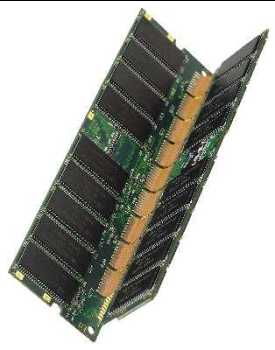
A half-open FEMMA Module
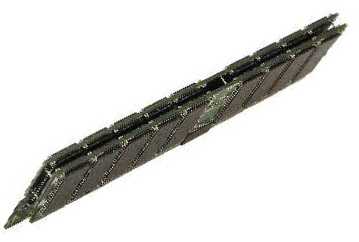
A closed FEMMA module from above
Kentron's FEMMA platform again targets thermal dissipation, reliablility and
density. It is scalable to future
chip technologies such as BGA (Ball Grid Array) and Flash. Kentron also says
FEMMA is by nature a much lower cost alternative to the chip stacking method
also used for high-density platforms. FEMMA eliminates the high cost of stacking
chips, the yield "fall-out" of stacking and the significant time delay of the
stacking process.
Along with standard Desktop DIMMs, FEMMA is also available in the SO-DIMM
format.
It appears that both Kingston and Elpida were hard at work trying to perfect the
stacking dilemma independently.
The EPOC and Elpida 2GB modules are different although the basic concept is
similar--that an elevated package is
used to hang over a lower tier package without contact, which is better and
simpler than prestacked packages. The
difference is that EPOC use more cost effective TSOP packages on the top and
small CSP at the bottom, whereas
Elpida uses more expensive TCP on both tiers. The top TCP packages must have
longer leads to avoid tangling up
the leads of the lower tier TCP, thus, more space between adjacent packages is
required.
Meanwhile, Kentron has proposed the smaller 1.2 inch size DIMM as a new industry
standard to JEDEC, the
engineering standardization body of the Electronic Industry Alliance. The
standard is needed, the company said,
because as the Internet grows, the need for higher memory and more servers grows
along with it.
While these memory module technologies are currently targeted towards the
server market, the main advantages of
density, size and thermal dissipation also apply to desktop systems, and server
technology always filters down to
the desktop market at some point.
Kingston's EPOC technology is currently shipping for PC133, Registered, ECC, 1GB
modules, with DDR coming very soon. Elpida offers their technology as a 2GB DDR
SDRAM DIMM, while Kentron offers FEMMA in a variety of formats, for both SDR and DDR SDRAM and at various sizes.
Special thanks to Heather Jardim at Kingston for the EPOC Technology images.







